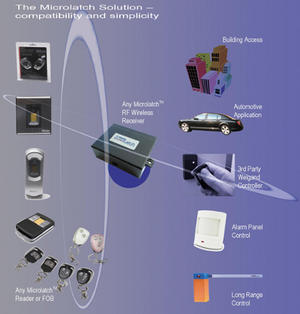New solution offers biometric security to mobile devices
Aussie company offers a biometric security solution for mobile devices; a Bio-button token is authenticated by the user, and as long as the Bio-button remains in the range of the mobile device, the authentication will remain active. This means that if the phone or mobile device is stolen, lost, or moved away from the token, the pairing is disconnected and the authentication broken

The Microlatch solution // Source: microlatch.com.cn
As more and more people use mobile devices even for sensitive transactions, the need to offer security solutions for such transactions becomes more urgent. A solution from Sydney, Australia-based Microlatch caught our eye. The company recognized this need, and is offering a new Bluetooth “bio-button” mobile security system. Microlatch says it has created a system that will conveniently and effectively shut down Internet fraud while, at the same time, creating a convenient all-in-one, secure mobile phone (or mobile device) solution to access control, mobile banking, online shopping, home automation, alarm systems, computer and network logins, and any number of customized access or login scenarios.
The patented, three factor security approach uses biometrics to provide positive ID in conjunction with mobile phones using a bluetooth interface.
The company says that this method of ensuring positive ID through a biometric “Bio-button,” which is wirelessly paired and tethered to a mobile device, resolves the security risks inherent in keeping the registered users’ biometric data and digital keys stored on such devices.
The “id-me” application allows users to configure various levels of security. The Bio-button is a token paired and tethered to a mobile platform. The token is about the size of a large coin, and the user authenticates the device when switching the mobile device on to establish an authenticated connection that then tethers the Bio-button to the mobile device for as long as the user wants.
The Bio-button also vibrates if the pairing is broken, signaling the user that they have been separated from their mobile equipment. Conversely, if the Bio-button itself is stolen or lost, then the mobile device, when configured correctly, will also signal the user by ringing, vibrating, or placing a message on the screen — or a combination of all three.
While the Bio-button remains “in field” of (or “tethered” to) the mobile device, the device is biometrically authorized to access any number of access controls or secure transactions via a software interface and utilizing different communication connections available to it through the mobile device, .such as WiFi, Bluetooth, or physical connections such as USB.
If the mobile device is stolen, the pairing is broken and the encrypted contents of the “mobile device stored” digital keys cannot be accessed.
The company says the application will be designed so the user can safely make an encrypted backup of their stored keys. This backup can be downloaded onto a new mobile device and activated via the original Bio-button.
The company notes that the Bio-button will also act as a user-configured emergency “set of keys” in manual, stand-alone mode. Additionally, in a worst case scenario — that is, if both a tethered mobile device and the Bio-button are stolen or lost simultaneously — then the user, through a secure, registered Web site can remotely break the tether, thus rendering the contents of the mobile device safe and inaccessible to the “would be” thief.
